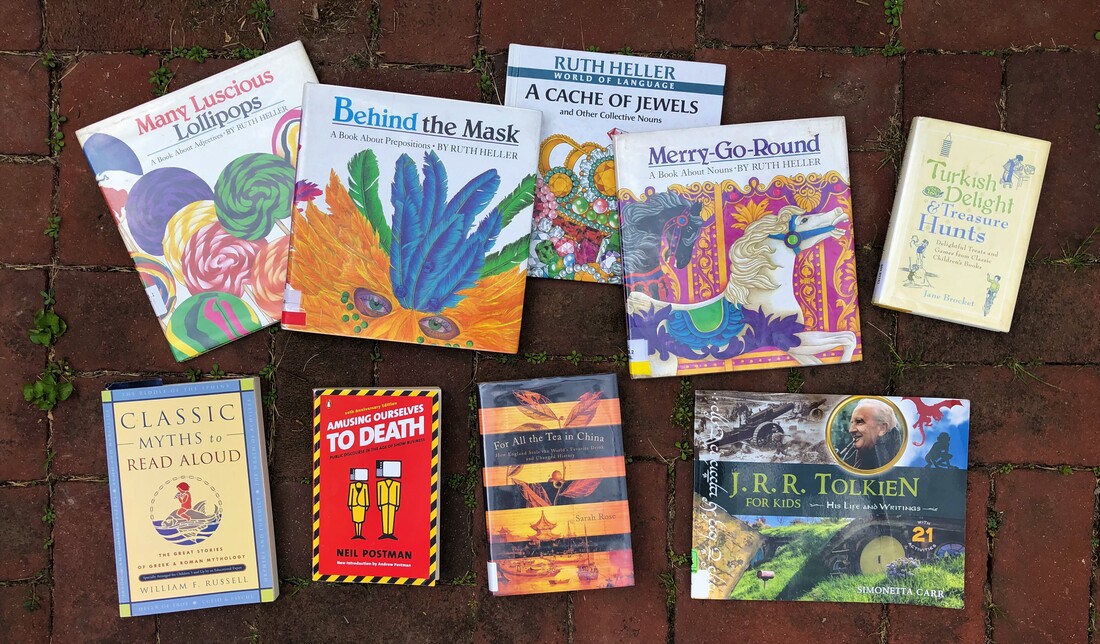|
For Your Kids
We all love our kids to read biographies of famous figures, especially famous Christians. J.R.R. Tolkien for Kids by Simonetta Carr is just such a book… but with a fun twist. In the book’s eight chapters, Carr tells the life story of this much-loved inventor of Middle-earth from his childhood through his retirement. But scattered amongst the narrative of his life and literary achievements are instructions for projects: a recipe for marmalade, directions for building a kite, a sample of a fictional map, a guide for inventing a new code, and many others. While the text of the biography may be slightly advanced for elementary reading, the projects are spot-on for kids in grades 3-ish through 6-ish. That makes this an ideal book for home educating families: enjoy the biography as a read-aloud, or let older kids read it solo, while the whole family can choose a few projects to try together. Grammar. I love it. Maybe you do too, or maybe it’s among your fake-it-til-you-make-it subjects. Either way, this collection of grammar picture books from Ruth Heller is likely to be a treat. It will either make you grin with the way she plays with parts of speech, or open your eyes afresh to how our lovely language works. I especially like Many Luscious Lollipops, the one on adjectives, but they are all good. The aptly titled Classic Myths to Read Aloud, collected by William Russell, makes myths bite-sized. A few years ago, I was astounded to learn how little of Greek and Roman mythology I actually knew. If you’re in a similar boat, knowing where to start can be daunting. Many great anthologies of mythology are available, and this is just one good one. Each story is preceded by a short summary along with a pronunciation guide for the names, and description of each character. The myths are short, and each one even tells you how long it takes to read aloud! It’s been a great mythology introduction for me and my kids! For You If your tea comes in gauzy paper packets (like mine does), you may not even know what a tea plant looks like. I didn’t. You may also, occasionally, stumble over the realization that tea is not native to England, yet seems to issue forth from that motherland like the steaming of great boiling teapots. For all the Tea in China by Sarah Rose will set the record straight. It’s a fascinating look at the history of the tea trade, its link with the opium trade, the geopolitics of the nineteenth century, and the journey of a botanist-turned-spy into the interior of China on a quest to collect living tea specimens. It’s told in sparkling detail and laced carefully together with firsthand accounts. Recommended for any tea-drinker! Have you read the first few chapters of Amusing Ourselves to Death by Neil Postman? It’s not too late to join the community-wide read-along as we prepare for our Parent Book-Talk this fall! If you haven’t started yet (or even if you have!), here’s a shameless plug to add this book to your nightstand or coffee table or library hold list. Postman wrote his book in 1984, an ominous year if ever there was one. But though the reality of 1984 was nothing like George Orwell’s famous predictions, the predictions that Postman made in Amusing Ourselves to Death (now nearly forty years ago) have been uncannily accurate. He worried that the cultural conversation would shrink to its least common denominator, i.e. the media of the masses. Today, this is precisely what we see in a world dominated by the ultra-brief clip. He foresaw the shift from the preeminence of print, which is necessarily slower in all ways, to the preeminence of the screen, which capitalizes on a far shallower and quicker form of thinking. Possibly most intriguing of all, he briefly discusses the two dystopian pillars: 1984 and Brave New World, suggesting that “Orwell feared… those who would ban books. What Huxley feared was that there would be no reason to ban a book, for there would be no one who wanted to read one.” And isn’t the unnerving plight in which we now find ourselves? Amusing Ourselves to Death isn’t an easy read, but it’s a gripping one. Get a copy so you can catch up and join the conversation this October! For Both You and Your Kids Have you ever longed to enjoy a riverbank picnic? Sip campfire cocoa or make toast over a fire? Make paper dolls (and not the storebought kind) or magical chalk-drawing lands? I know you have. Turkish Delight and Treasure Hunts by Jane Brocket is the book for you (and for your kids). Collecting inspiration from classic children’s books like The Wind in the Willows, The Lion the Witch and the Wardrobe, A Little Princess, A Wrinkle in Time, Heidi, The Borrowers, Betsy-Tacy, and many more, Jane Brocket (whose name sounds like it was lifted right out of one of those stories!) provides instructions for bringing the activities of our best-loved characters to life. Her introduction alone is splendid, exploring the reasons why some activities that make up children’s literature are not feasible for attempting in “real life.” Yet she yields to the magic of making a cake from scratch, decorating a hat with flowers, creating a tiny post office or secret spot, or even sitting up late to enjoy a dark and stormy night. This book is good enough to read even without scheduling the activities. But you’ll want to try them all.
0 Comments
|
curated by Brittany Mountz
English major and unsuspecting English educator at ALC Archives
May 2024
Categories |

 RSS Feed
RSS Feed